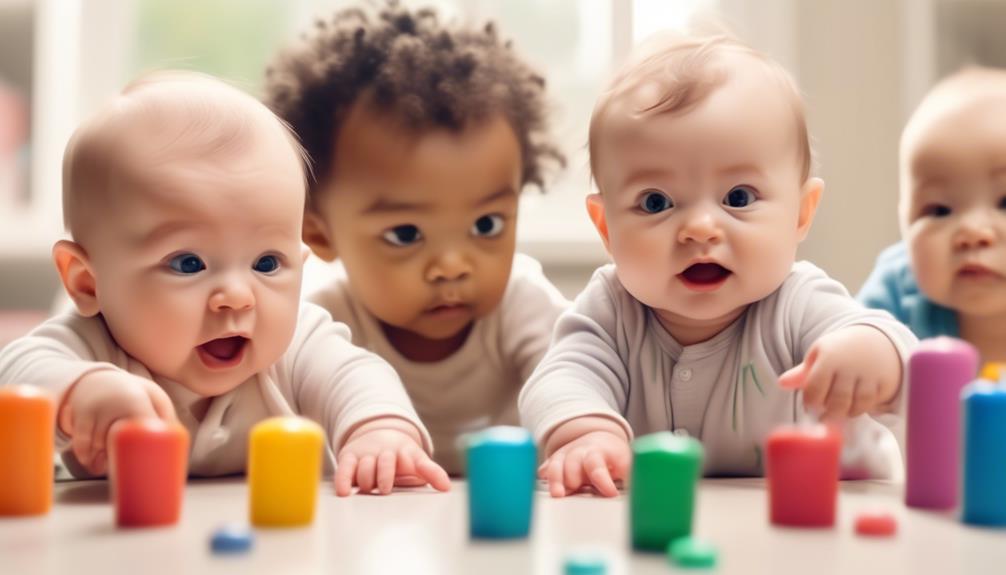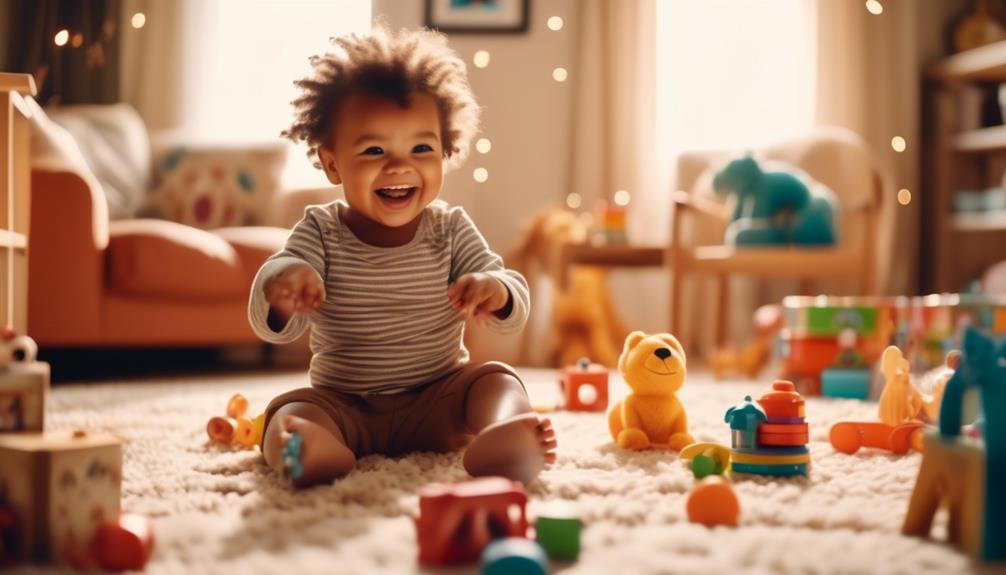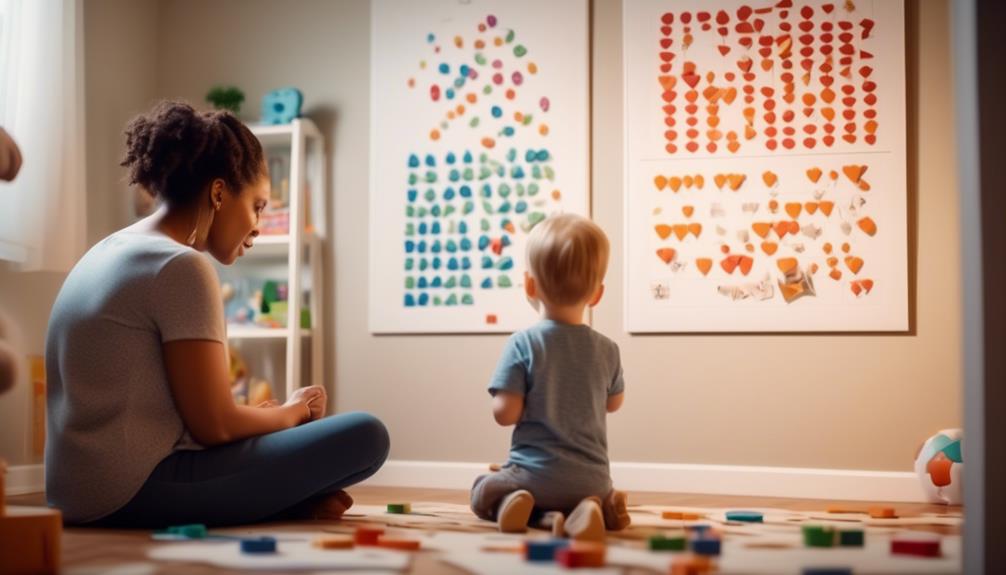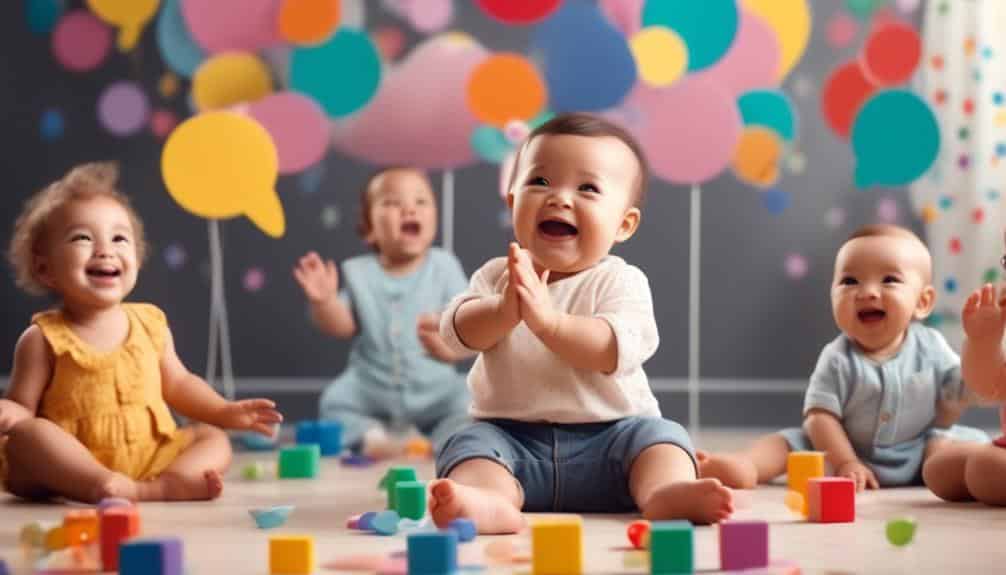As you embark on the fascinating journey of parenthood, you’ll soon arrive at the milestone where your little one begins to talk, a gentle transition from the coos and babbles to discernible words. When children begin to talk, they often offer a glimpse into their burgeoning language skills as they approach the one-year mark, although the range of when this occurs can vary widely. You’ll discover that by the time they celebrate their first eighteen months, many toddlers have a vocabulary that includes a handful of words, and you may even witness the beginning of two-word sentences as they approach their second birthday.
While these general timelines provide a scaffold for expectation, it’s crucial to appreciate the unique tempo at which each child unfolds their verbal tapestry. What you may not realize is how the nuances of language development can signal more than just the ability to communicate—it can be a window into cognitive, emotional, and social growth. Stay tuned to uncover the signs that indicate typical speech progression and the red flags that suggest it might be time to seek guidance.
Key Takeaways
- Speech development begins with early babble around 4 to 6 months of age.
- First words typically appear around 12 months, with toddlers starting to string words together by 18 months.
- Vocabulary expansion is crucial for expression and comprehension, with milestones of 20-50 words at 12-18 months and 50-100 words at 18-24 months.
- Toddlers start combining words into phrases and forming simple sentences around 18-24 months of age.
Recognizing Early Babble
Infants typically demonstrate early babble as early as 4 to 6 months, marked by vocalizations such as cooing and simple consonant sounds. This stage is pivotal in a baby’s language development; it’s when your little one starts their journey toward speaking. Recognizing early babble is critical to gauging their speech development and understanding their needs and emotions.
During this period, babies experiment with their vocal tracts by producing sounds that echo the rhythms and patterns of language. They’re not just making noise—they’re beginning to understand how to form sounds that eventually lead to their first word. You’ll notice that their sounds become more complex as they start babbling, showing their growing proficiency with language skills.
Early babble is not only about sounds; it’s also about response and interaction. Babies learn through imitation, so they practice communication when you talk to them and babble back. Pay close attention to these early signs of language acquisition. Your role in engaging and responding to these initial attempts at speech is crucial for their continued progress in learning how to talk.
Begin to talk: The first words.
Babies typically utter their first meaningful words around 12 months, signaling a significant milestone in their linguistic development. These initial utterances are pivotal language milestones, often reflecting the baby’s immediate social and material world. When babies say their first words, it provides a window into their cognitive and speech development processes.
The emergence of a baby’s first words is a complex, individualized event, and while the average is around 12 months, the range can vary. Here’s what you need to know:
- Babbling to Words: Starting with babbling at six months, babies gradually refine their sounds to articulate their first words, often echoing the language patterns they hear.
- Word Expansion: By 18 months, more explicit speech emerges, and a toddler’s vocabulary expands rapidly, preparing them for simple phrases at 24 months.
- Gender Differences: Boys may experience a slightly slower pace in language development than girls, with both typically reaching key speech milestones by age 3.
- Monitoring Progress: Be alert to signs of a speech delay; if a child hasn’t started saying their first word by 15 months or has a limited vocabulary of fewer than 25 words by age 2, consider consulting a Child Speech and Language specialist.
Vocabulary Expansion

Following those initial steps in language acquisition, children continue to broaden their vocabulary, which is vital for their ability to express thoughts and comprehend the speech of others. This vocabulary expansion is a cornerstone of speech or language development. When your baby says their first words, it’s just the beginning of a fascinating journey of language explosion. As children learn simpler words, they start to put words together, forming basic sentences that reflect their cognitive development.
Early intervention is crucial; it supports and fosters this growth, promptly addressing any speech delays or disorders. As children’s vocabularies expand, their ability to engage with the world around them is enhanced significantly. This expansion paves the way for academic readiness and social interaction skills.
Here’s a brief overview of vocabulary milestones in early childhood:
| Age Range | Expected Vocabulary | Developmental Significance |
|---|---|---|
| 12-18 months | 20-50 words | First words, gesturing |
| 18-24 months | 50-100 words | Words together, simple phrases |
| 2-3 years | 200-1,000 words | Language explosion, sentences |
| 3-5 years | 1,000-2,000 words | Complex ideas, storytelling |
These figures are averages and can vary widely. Encouraging a rich linguistic environment can significantly expand a child’s vocabulary, enhancing their overall cognitive development.
Combining Words
You’ll notice a significant leap in your toddler’s language skills around 18 months when they combine words into phrases. This advancement is a crucial language development milestone, indicating increasing cognitive abilities and understanding of syntax. By turning two, they typically begin to form two-word phrases and simple sentences, signaling further vocabulary expansion.
Early Sentence Formation
Combining words into early sentences typically emerges in toddlers between 18 months and two years old, marking a significant milestone in language development. As you guide children through this phase, you’ll notice a transition from single-word utterances to more complex structures. Here’s what to look for:
- Two-word sentences: Babies start making simple combinations like “more milk” or “mommy go.”
- Three-word sentences: Some children begin to string three words together, forming early phrases such as “See big dog.”
- Understanding: Even when sentences are grammatically incorrect, it’s clear that toddlers understand the concept of combining words to convey meaning.
- Bilingual Development: Children learning multiple languages may develop this skill slightly later, yet they follow a similar developmental trajectory.
Encouraging early sentence formation is crucial as children learn language and express themselves more fully.
Vocabulary Expansion Milestones
As toddlers reach the 24-month mark, they typically combine words, signaling a significant leap in their language development. This vocabulary expansion reflects their growing ability to form and express more intricate ideas. Initially, children in the US and worldwide might string together two-word phrases like “more milk” or “big dog.” These speech milestones are critical indicators of early language development and the culmination of months of linguistic growth since uttering their first words around 12 months.
This progression demonstrates a quantitative increase in vocabulary and a qualitative enhancement in how babies begin to use language to interact. As they learn to talk, common first words evolve into more sophisticated constructs, reflecting an ever-expanding understanding and communication capacity.
Understanding Milestones

You’ll notice that speech development follows certain stages, with babbling morphing into word formation and, eventually, phrase creation. It’s essential to recognize variability in when children hit these milestones, and factors such as gender may influence the pace of language acquisition. If you’re concerned about your child’s progress, early communication signs and professional guidelines can help determine if intervention is needed.
Speech Development Stages
Understanding speech development milestones helps us track the progression from a baby’s first coos to their initial words. These stages are essential for identifying typical language development and potential speech delays. As you support early language acquisition, it’s important to recognize:
- Babbling is a critical phase that starts around six months, with babies experimenting with cooing, sighing, and consonant sounds.
- Around nine months, babies often combine sounds into syllables, showing the foundations for verbal skills.
- The exciting moment when babies talk and say their first words typically occurs near the 12-month mark.
- By 18 months, toddlers begin stringing words together, signaling a surge in speech development stages toward more complex speech or language use.
Recognizing Milestone Variability
While speech development stages provide a framework for observing early language acquisition, it’s crucial to note that children reach these milestones at their own unique pace. Language development exhibits a wide range of standards, reflecting milestone variability. For instance, while many children begin to babble at around six months, this isn’t a fixed schedule. The journey from a baby’s talk to a child’s language involves numerous individualized steps. Some may speak their first words earlier or later than the typical one-year mark.
By 18 months, the expectation is often a blooming vocabulary; however, some children may still be on the cusp of this verbal explosion. It’s essential to understand that as children begin to use words, the timing of these language milestones can vary significantly.
Early Communication Signs
Babbling, which marks the advent of verbal communication, typically emerges around six months of age and lays the groundwork for future speech development. As you observe babies learn and grow, you’ll notice that these early communication signs are critical milestones. Babies progress in word development before they start talking and form their first words.
- Babies begin to use varied sounds to communicate needs and responses.
- They’re able to understand simple words and commands before they can speak.
- Gestures and changes in tone can indicate a readiness for more complex language skills.
- Early intervention, such as speech therapy, is beneficial if you suspect delays in language acquisition.
Understanding these signs helps you support infants as they navigate their linguistic journey.
Encouraging Speech Development

To foster speech development in children, parents and caregivers can engage in activities like reading aloud, singing, and narrating everyday actions to encourage imitation and language acquisition. When your baby points at something, use the moment to say the word clearly and perhaps repeat sounds to help them learn. Babys’ funny little noises begin the Sweetest Baby Milestones in language development.
| Activity | How It Helps |
|---|---|
| Reading books and singing | Builds vocabulary, understanding of sounds and rhythms |
| Narrating actions | Reinforces the connection between words and their meanings |
| Imitation games | Encourages trying out new words and sounds |
By the time your little one is ready for their first words, typically around their first birthday, they’ve been tuning into your language for months. Teach Your Baby to associate words with actions and objects to make this leap in development. Boys might lag slightly behind girls in language skills, but with your supportive environment, they’ll likely catch up by age three.
If by 15 months your child hasn’t spoken their first words, or by age two, they have less than 25 words, consider consulting a speech-language pathologist. Remember, each child’s development is unique, and your attentive support is critical to nurturing their growth.
Identifying Speech Delays
How can you tell if your child is experiencing a speech delay? It’s essential to monitor your child’s progress against developmental milestones recommended by the American Academy of Pediatrics. Understanding the typical timeline for language development helps you identify speech delays early on. Here’s what to look out for:
- By six months, babies usually start babbling. If, by nine months, your child hasn’t begun to string sounds together, it might be a sign of a delay.
- A lack of a first word by 15 months is another key indicator. Most children say their first words around this age.
- Having fewer than 25 words by age 2 is a notable sign; seeking professional advice is wise.
- If your child doesn’t respond to their name, shows limited interest in communication, or has difficulty following simple directions, these may be signs of speech delay or issues with receptive language.
Early intervention is essential for children with speech delays, which may be due to various causes, including hearing impairment or being on the autism spectrum. Speech skills are foundational for future success; timely support can make a significant difference.
Seeking Professional Assistance

Should your child exhibit signs of speech delay, such as not babbling by nine months or not responding to their name, it’s crucial to seek a doctor’s evaluation promptly. The American Academy of Pediatrics recommends that parents observe their child’s development, particularly regarding language sounds and the milestones of saying their first words. If by 15 months, your baby hasn’t begun to say words, it’s advisable to get medical advice.
When babies begin learning to talk, each developmental stage is a building block. If by age 2, your child has a vocabulary of fewer than 25 words, seeking professional assistance is recommended to address potential language delays. Developmental screenings during well-child visits can be instrumental in identifying any delays as early as possible.
Utilizing Pediatric Speech Therapy
Pediatric speech therapy is often crucial in helping children with language delays reach their communication milestones efficiently. When you’re eager to hear your child say their first word, it can be concerning if they’re not meeting the typical timelines for babies to say “mama” or “dada.” The American Academy of Pediatrics recognizes the importance of early language development and how pediatric speech therapy can assist in guiding children to begin talking.
In pediatric speech therapy, therapists tailor activities to each child’s needs, fostering an environment where children can develop language skills and work towards articulating first words. Here are several ways speech therapy can support a child’s communication journey:
- It engages in play-based activities that promote using first words and language structure.
- They are educating parents and caregivers on strategies to encourage language development at home.
- They address specific challenges, such as articulation disorders, and help children say their first words clearly.
- It provides an early intervention that targets language comprehension and social communication skills.
Celebrating Communication Progress

As children reach new language development milestones, it’s vital to acknowledge and celebrate each step forward in their communication journey. When your baby starts babbling around six months, they’re laying the groundwork for verbal communication, experimenting with sounds that eventually form actual words. By nine months, they may begin stringing these sounds into multiple syllables—a precursor to talking in sentences.
When your baby is around a year old, you’ll likely hear their first words, a momentous occasion that deserves recognition. This is when they understand what you say and try to communicate back. Celebrating communication progress at this stage reinforces their efforts and encourages further development.
As they approach two years, combining words into simple phrases marks another significant milestone in their ability to express themselves. Remember, every child’s timeline is unique. Whether it’s the emergence of a new word or a slight improvement in articulation, each achievement in your child’s language development is a cause for celebration.
Frequently Asked Questions
Should a 2-Year-Old Be Talking?
Yes, you should expect a 2-year-old to be talking, typically combining words into simple phrases. If they’re not, consider consulting a healthcare professional to evaluate their language development.
What’s the Earliest a Child Can Talk?
The earliest a child can talk is around six months with babbling, progressing to essential words at about 12 months, and simple phrases by 24 months, though it varies individually.
What Is the Average Age a Child Talks?
As you navigate the early language labyrinth, remember that the average child starts talking around 12 months, with their vocabulary blossoming by 18 months and phrases forming near their second birthday.
When Should You Worry if Your Child Is Not Talking?
If your child isn’t talking, consult a doctor at 15 months or with less than 25 words by age 2. Early intervention for any speech delay signs is crucial for support.
Conclusion
Babies learn language skills at their own pace. Most toddlers can speak two-word sentences, such as “mama, dada,” and answer simple questions or instructions by age two. Suppose your child has been using baby talk for the past two years. In that case, it’s recommended to consult a healthcare provider or speech-language pathologist to check for speech delays or language development issues.
Language development is a gradual process marked by language milestones, such as saying simple phrases, singing songs, and using verbs. Exposure to language, one-on-one interaction, and everyday objects can help with language growth. The American Speech-Language-Hearing Association recommends an age-appropriate range of language skills for babies and toddlers, including detailed and complicated sentences.
Late talkers or children who make mistakes with speech may need speech therapy to help improve their communication skills over time. Speech professionals can assess speech sounds, identify speech disorders, and provide clinical applications. Pictures in books, animal sounds, and question inflection can help children master language sounds.
Parents and caregivers can help by checking for signs of speech disorders, such as limited or loud vocabulary, and ensuring the child has good hearing. One-on-one interaction, including back-and-forth conversations and 2-step instructions, can also help with conversation skills. It’s essential to seek qualified experts for concerns about a child’s communication development.


Recent Comments